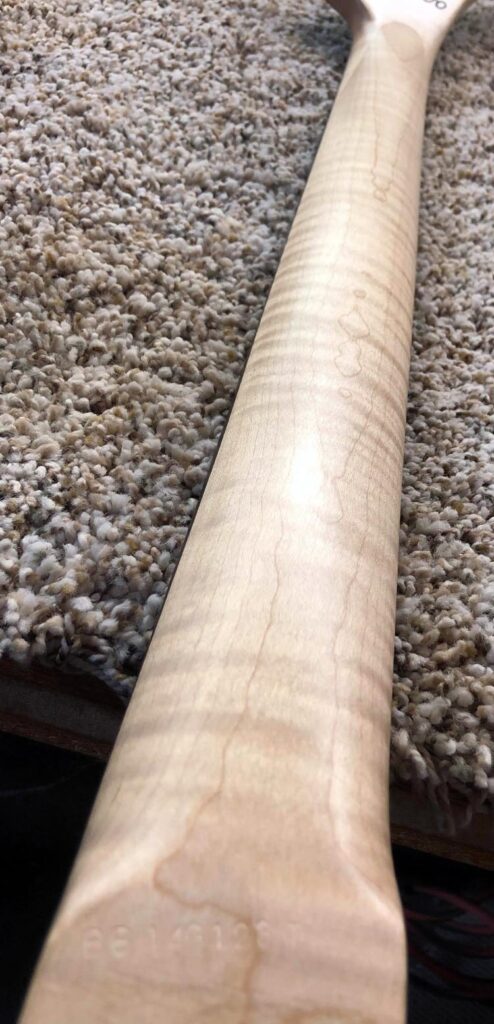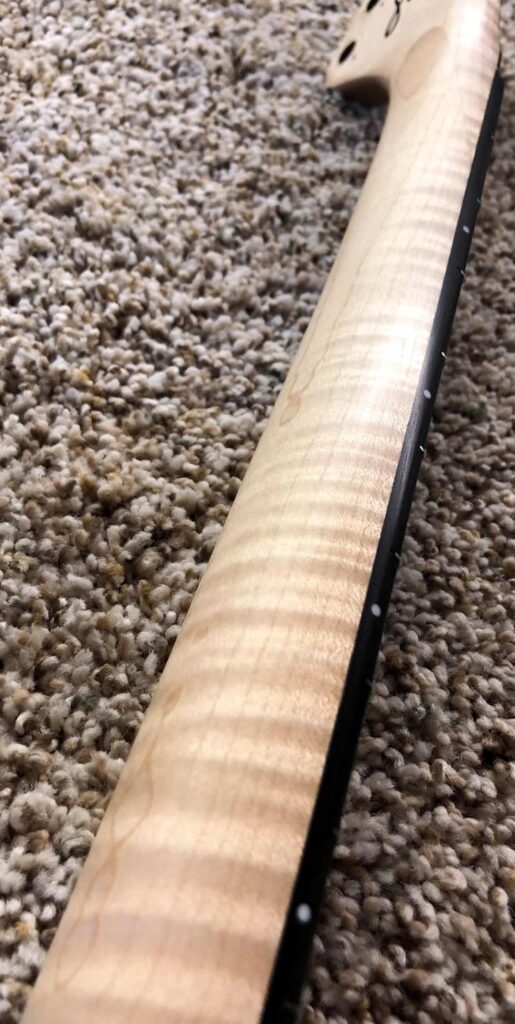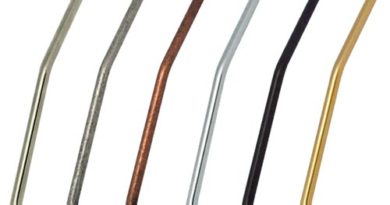Flattening The Hills: Fixing A Fretboard, pt 3
Do you have that one guitar? You know the one. Sure, there is the special unicorn that always shines like a rainbow and sounds like thunder from on high. But this is that other one. HaHa! The impulse purchase that never loosens the clutch on your workbench or your wallet.

At some point, it is not uncommon to grow weary of the garden-variety mass-production offerings being put together across the ocean. Perhaps you like many features from many guitars and want to bring it all together. In the YouTube era of the instant rock star, you may want something different to set you out from the crowd. Or any one of the countless reasons that a player might think of a “specialty” or a “showcase” instrument.
Let’s say you find a luthier. Or at least that’s what they call themselves. You are being fed the music industry stories and there is the razzle-dazzle of presumptuous associations. The little voice of common sense nagging you to be at least as equally critical of the inspection of the QC as of the hefty price on the tag is choked out. A strangling from that “luthier” suggesting to you that it’s all by feel, and that measurements don’t matter.
That’s a good way to end up with a turd. A big loose steaming pile of a Wednesday-morning-after-Taco-Tuesday double-flusher. You know the one, if you follow the previous articles Grading On A Curve and Bumps In The Road. Yes, it’s that neck. Again! LOL!
In those previous articles, it’s about discovering the erratic fretboard radius and the rickety fret installation. Both are conditions of how it came from that.. ahem… “luthier”. But, you say, there is already a fretboard re-radius and a re-fret on the books? Yep. Oh, that it were so simple, gentle reader. HaHa! It persists.
This time I am shipping it to a pro to resolve the failings once and for all. The shop works with artists that include Steve Stevens (Billy Idol, Kings Of Chaos, Atomic Playboys), Doug Pinnick (King’s X, KXM), Mike Inez (Ozzy Osbourne, Alice In Chains), Dino Cazares (Fear Factory, Divine Heresy), and more.
Cosmetics
Think about the finish that you find on the back of many necks. In this situation, it’s a glossy clear that is thick with a candy shell sort of quality. It seems the purpose is more to detail the flame of the maple. The culprit here is that the clear extends up to cover the edge of the ebony fretboard. That in of itself might not be so much the problem as to the quality of the application of the clear. During the re-fret, this clear reveals itself to be quite brittle, chipping and flaking off the sides of the ebony fretboard. It looks particularly trashy.
Here are some examples:
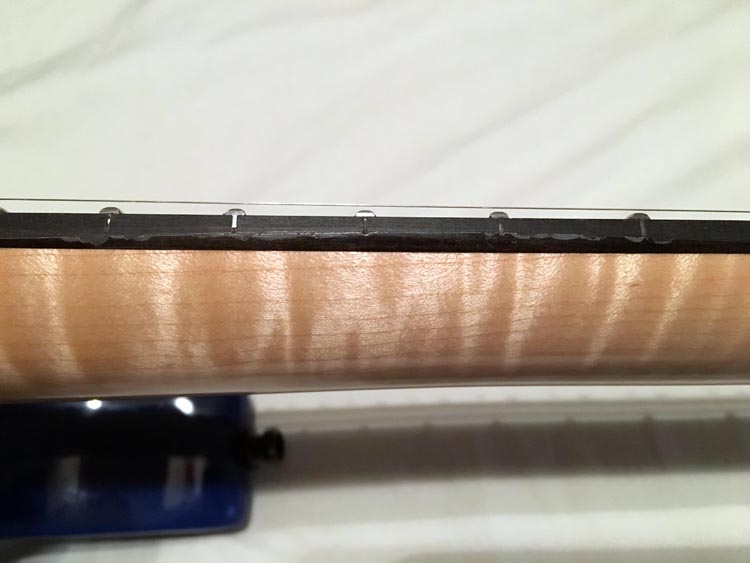
Fretboard High E Side w/ Flaked-Off Clear 
Fretboard Low E Side w/ Chipped-Off Clear
The cause can be a few things. The prep work, poor adhesion, or the properties of the clear product are some of the possibilities. I have the opportunity to be in contact with several former customers of this brand. One gentleman has rather specific comments about experiences with the clear coat. Seems this is not isolated.
When the shop is removing the clear, this video and photo are taken:
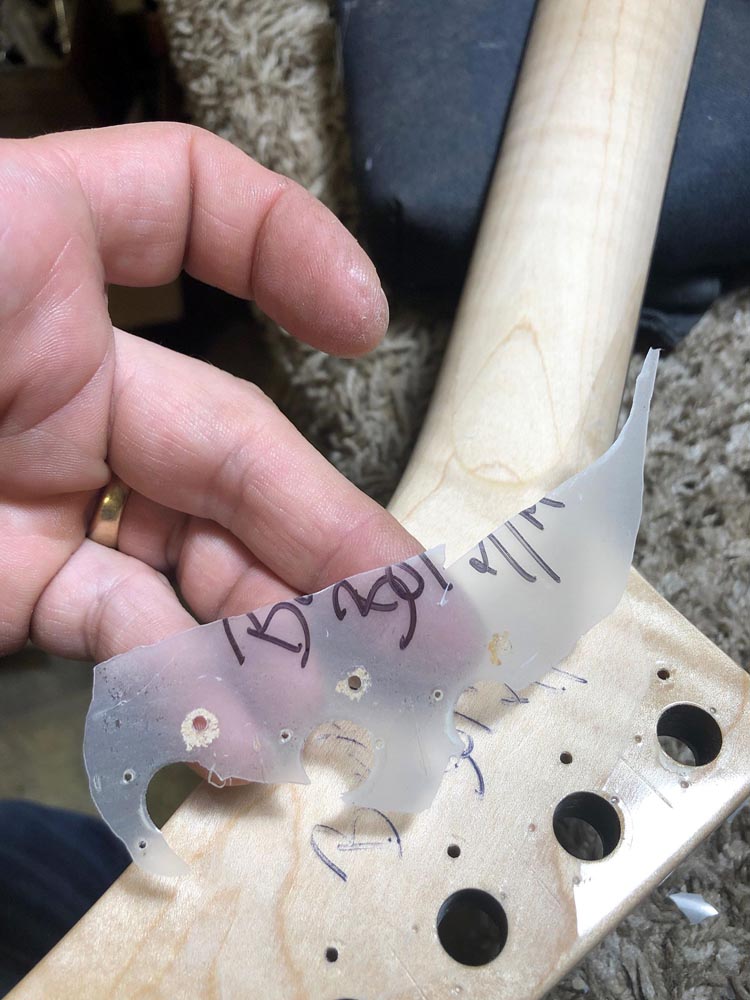
Sheesh! Look how thick that is. This is a solid 6 years old clear coat that lives in an air-conditioned environment with no exposure to elements to cause anything like that. Which is to say, that’s totally on the “luthier”.
While there is the temptation to leave the wood natural, the recommendation is to seal it up. The General Finishes Gel Topcoat is in play here. This type of sealer is a secret weapon in the finishing arsenal of several guitar companies which I cannot mention. But you’ve heard of them.
Functional
During the shop’s evaluation of the neck, it comes out that part of the issue is a fretboard hot-spot around the 3rd to 5th frets. This is apparently from a poorly assembled scarf joint (aka luthier’s joint) with probable slippage prior to settling. You can get an idea here:
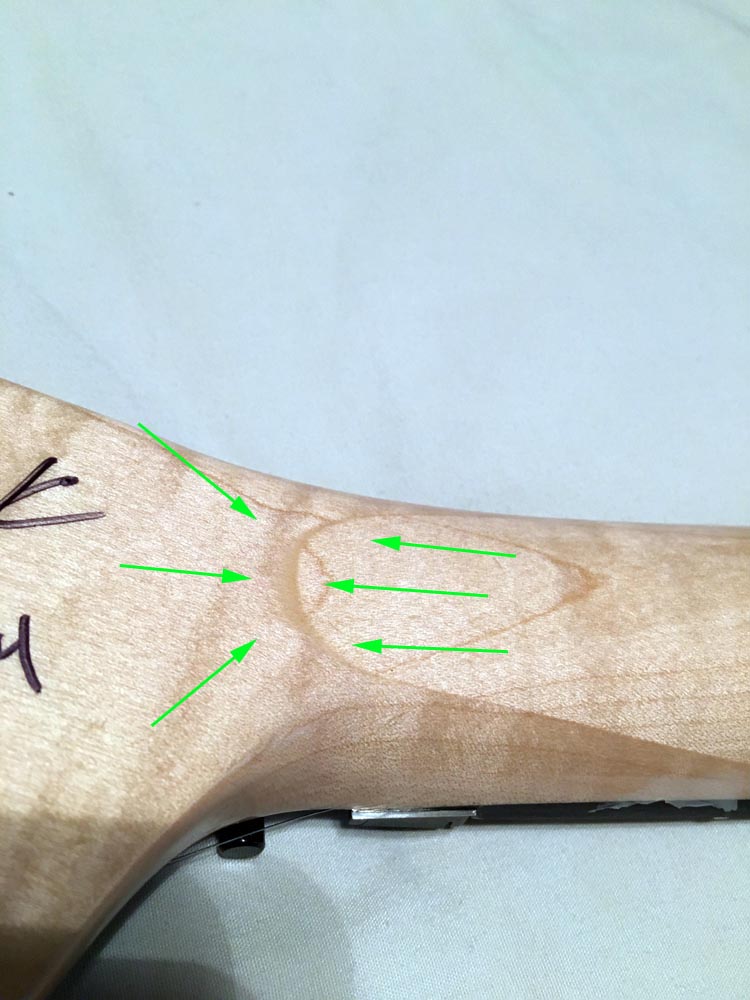
Luthier joint, showing poor construction technique 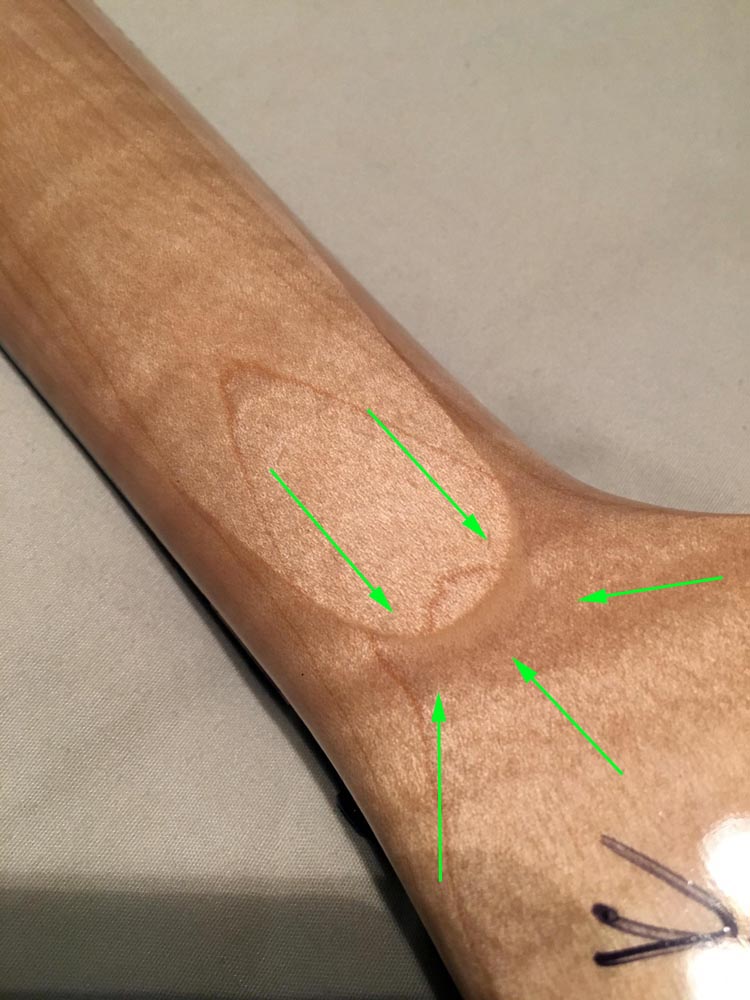
Luthier joint, showing poor construction technique
The dull-looking crescent shape favoring the headstock side of the joint. That’s not a good thing. LOL!
A few things are coming to mind right about now, aren’t they? HaHa! First, replace the neck!! Well, it has a weird scale length of 24.5″. That’s right, the Santana scale length. Not 24.75″. Remember that whole part about taking some measurements and how a siren should go off if you’re getting lip about checking the work? Plus, 24.5″ is in to the custom build territory and that is not just sitting on a peg down at the Guitar Center.
Second, take it back! It’s already been taken back a few times for other work. Which leads to another takeaway: Avoid someone that gets belligerent about resolving problems with their product.
In an effort to find the silver lining, this is a great opportunity to fine tune (ha! a pun!) small details. The fretboard get a fresh 12° radius and a new re-fret. Check it out:
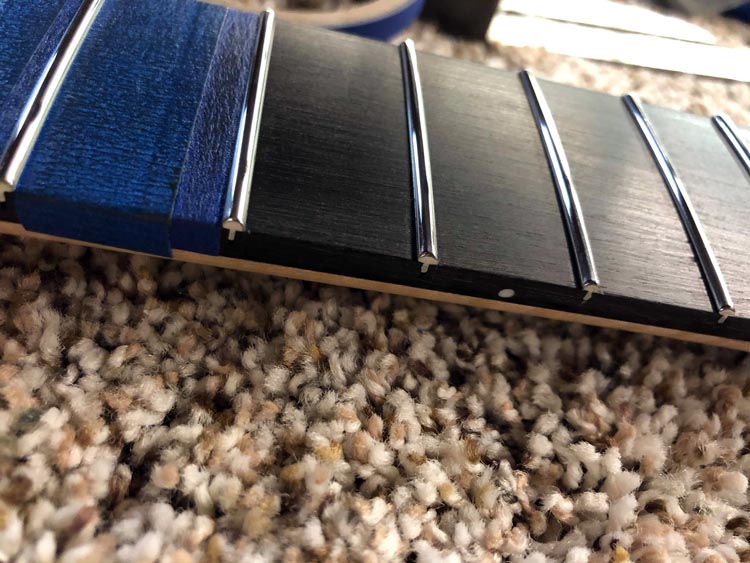

Fretboard w/ Jescar 47104 “Medium-Wide” Stainless Steel Frets 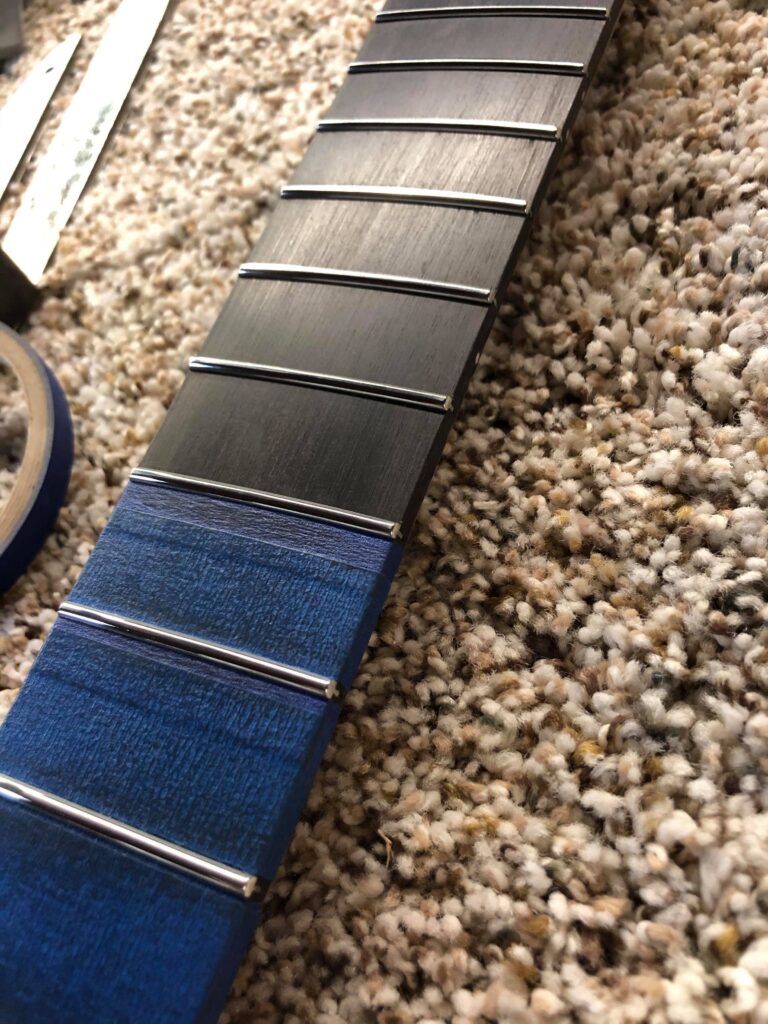
Fretboard w/ Jescar 47104 “Medium-Wide” Stainless Steel Frets
How about a quick snippet as well:
And what about that new sealer on the maple neck? Take a peek:
The Results
Looks fine. That’s not me being blasé. HaHa! Show me how it’s going to be stable and if it’s going to sound good. Showboating the flame is truly not all that and a bag of chips, at least not in my book. LOL! Still, as a matter of standard procedure, I did hit the ebony fretboard with some Lizard Spit FretBoard Conditioner.
Alright then, how stable is it? Good question. Given the history of the neck, there is the concern of exposing the bare wood. Even if just long enough to prep and re-seal. Why? It’s been sealed up tighter than a debutante on prom night. HaHa! How will it react to the elements? Turns out that it doesn’t take long to get it sealed back up and protected again. Once back on the guitar and under string tension, it’s holding the re-install truss adjustment like a champ.
How does it play? Now that this is all in place, it now feels the way it should have always been. The sealer leaves the neck feeling like one of the smoothest you’ll ever find. Then add a resolutely level fretboard and a top notch fret job. The re-install setup is no-hassle. Additionally, getting all that thick goopy clear off the wood opens it up a little more. In many cases, laying on lots of a heavy finish can make a guitar sound brittle and thin. Unyielding, if that makes sense. Now it has more of an organic and open character that fills out the sonic canvas.
The Takeaway
It can be embarrassing to get suckered in to a cult of personality being sold by someone that cannot deliver. Some might say this “luthier” is more of an assembler, slapping together CNC parts with no passion for the details. And it can be hard to see that when there are tall tales of legendary guitars. Yet time reveals that someone might just assemble pre-made parts ordered to the artist specs. Or that the work of an infamous paint job was actually someone else’s. Perhaps people that were there at the time say that the guy did little more than follow around the seasoned veterans, clamoring for the slightest clue. These are the days when someone might try to resurrect a flashy look from 30 years ago, then try to claim it as their own in hopes people forgot the origins.
When some people get bamboozled in to that and drop a chunk of change, they don’t want to admit to being taken for a ride. The confirmation bias makes one want to double down, lest the look like a bigger chump. Yet still they do. We fall so we can learn to pick ourselves up. Some rich dude’s butler says so. LOL! I’ll admit it.
At the end of this all, it’s cost enough to buy at least 2 sturdy, plain-jane guitars in place of this single flashy show-off. And that’s why you will see me putting together a few of my own. Warts and all. But at least they are my mistakes, and not the blatant screw-ups of a stolen-valor has-been masquerading as a “luthier”. HaHa!
So the next time you’re looking at a guitar, take your measuring tools with you. A notched straight edge, a small machinist ruler, a micrometer, some radius gauges, a fret rocker. Whatever you need to give it a basic once over. Most reputable stores will let you do that if you act like you can rub more than 2 brain cells together. LOL!
7 string 59 Alnico 2 Alnico 3 Alnico 4 Alnico 5 Alnico 8 Bare Knuckle BKP Brown Sound Celestion Ceramic Custom Shop Dean DiMarzio DMT Dual Resonance EVH Fishman Floyd Rose Fluence Gibson Humbucker Ibanez JB Jimmy Page John Petrucci MJ Mojotone P90 PAF Pariah Pickup Professor Guitarism Satch Satriani Schaller Seymour Duncan Singlecoil Single Width Speaker Steve Vai Tech Tip Tremolo Virtual Vintage



